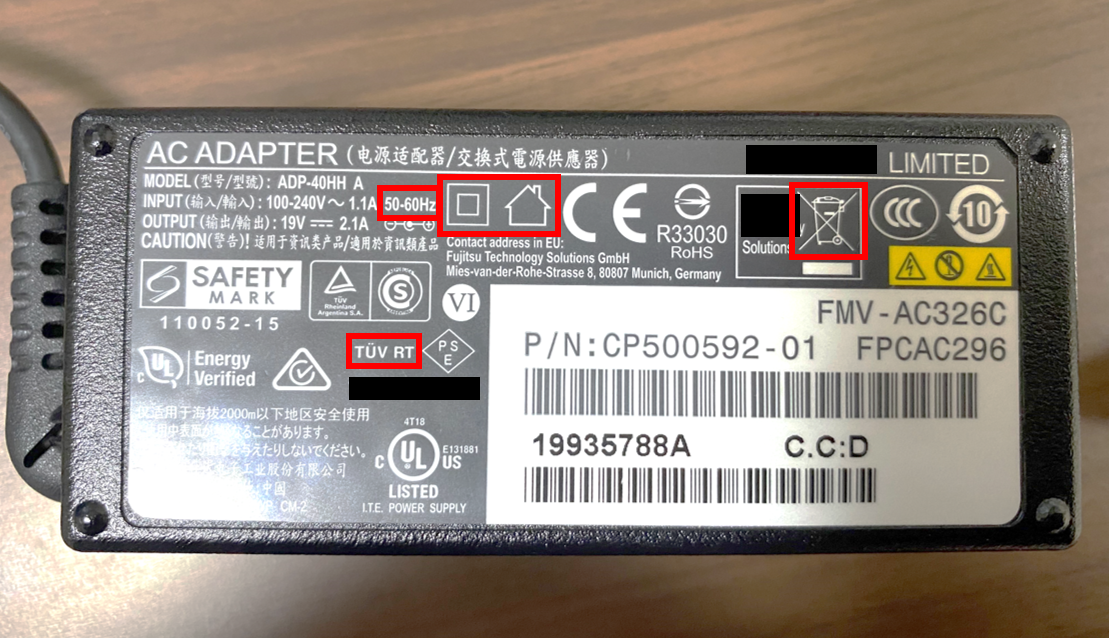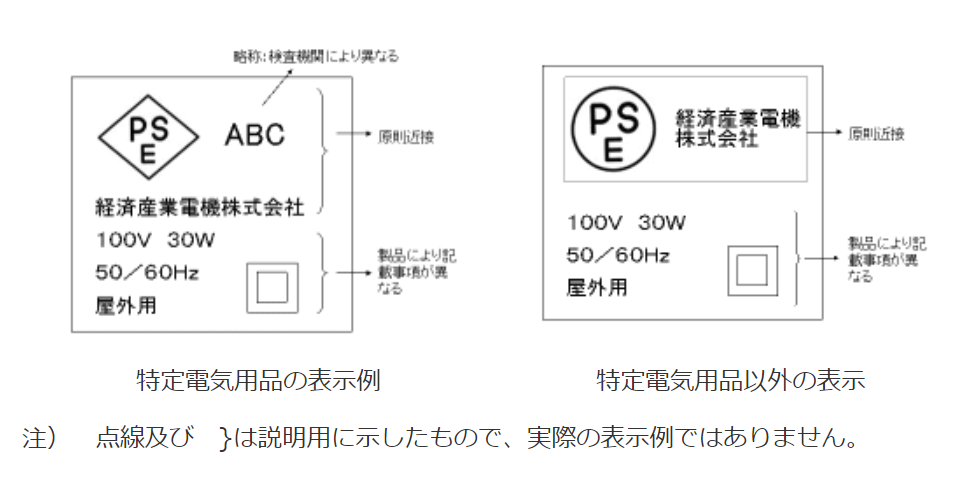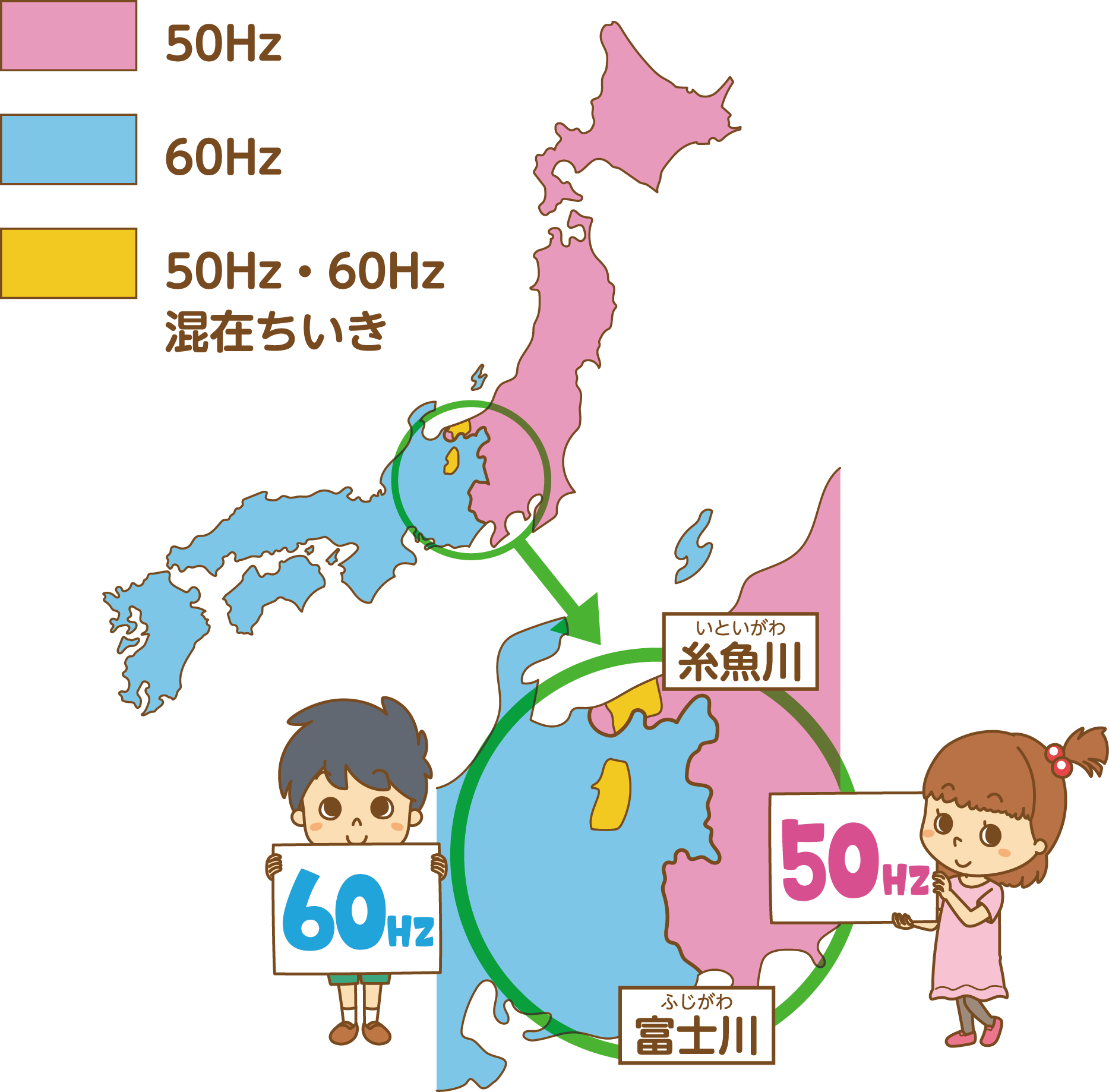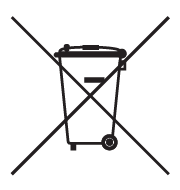[Certification Q&A (15)] We will answer the meaning of logos and letters on label labels such as the PSE mark (Electrical Appliance and Material Safety Act)

Hello. It is the moat of the caretaker.
Many inquiries about authentication are:
The Chinese factory in question seems to have obtained CE (European certification) and there is a label display, but is it okay not to do certification such as PSE or Radio Law?
It is the content.
CE certification is only a European certification, so even if you have obtained it, you will not be exempt from compulsory certification of Japan (PSE, Radio Law, etc.). However, I think it will be one of the proofs of the high quality of the product. However, it is also true that if CE is written on the label, it will be reassuring by itself.

It is a product label that we usually do not pay attention to, but it incorporates a large amount of contents including necessary and unnecessary. It is quite worrisome when you try to handle electrical appliances and materials as a business operator.
This time there were many inquiries, and I would like to tell you mainly whether it is mandatory to display or not.
Contents
Review of general PSE display contents

Because it is an adapter used overseas, there are many displays that are not directly related to PSE (Japan)
This image shows the PSE display of a typical laptop charger adapter. Since the contents that I want to convey just right are covered, I would like to give you an example here.
Based on the contents of this article, I would like to tell you.
In addition, the minimum contents that must be posted for PSE display are as follows. In addition to this, what needs to be posted will change depending on the product.
 Citation: Ministry of Economy, Trade and Industry_Flow of Notifications and Procedures_ Indication
Citation: Ministry of Economy, Trade and Industry_Flow of Notifications and Procedures_ Indication
Let's talk about the PSE display of the charging adapter.
Name of registered inspection body
If you are a general user yourself, it is a completely unrelated story, but if you are a business operator and in a position to sell PSE products, it is a place that you should be careful and check by all means.
In terms of the adapter in the image, TÜV RT is the name of the registered inspection organization.
This time, we are using the charging adapter PSE as an example, but for specific electrical appliances and materials (rhomboid-shaped PSE), it is necessary to display the name or abbreviation of the registered inspection organization that certified it, logo, etc.
The point to note here is that there is no instruction from the Ministry of Economy, Trade and Industry on which registered inspection organization name should be displayed. Businesses must obtain the logo data of the inspection organization themselves and display it themselves.
In some cases, the Chinese factory has already displayed the information, but the business operator is obliged to confirm for himself whether the contents are really correct.
The worst pattern is, for example, holding the certificate of Inspection Agency A, but displaying the logo of Inspection Organization B. This may not be a big problem, but if it is pointed out to the Ministry of Economy, Trade and Industry, it must be improved, and it is up to the Ministry of Economy, Trade and Industry to decide whether there is any reproach, so it is most important not to make unnecessary mistakes.
The list of PSE registered inspection organizations is summarized here, so please refer to it. In addition, the indication of the registered inspection organization is only for specified electrical appliances and materials, and it is not required for anything other than specified electrical appliances and materials.
Ministry of Economy, Trade and Industry (METI) Homepage_Electrical Appliance and Material Safety Act_List of Registered Inspection Organizations

50-60Hz
This means that the frequency of "alternating current" electricity taken from an outlet corresponds to two, "50Hz" and "60Hz".
If you are a little familiar with electricity, you may know that in Japan today, the east side uses electricity of "50 Hz" and "60Hz" electricity on the west side, bordering Fujigawa in Shizuoka Prefecture and Itoigawa in Niigata Prefecture.
The historical background that has become this is different from the purpose of this page, so I will not discount it, but if you are worried, please refer to the link below.
If a 50Hz product is used in western Japan, it may cause a malfunction. The opposite is true, and the same is true when a 60Hz product is used in eastern Japan. However, I don't know if there really is such a thing in modern products, but in theory it will be.
It is very rare to be divided into two frequencies in a country, and there are 50-60 Hz that can be used only at 50Hz, only at 60Hz, or both for electrical appliances and materials. And we need to show which frequency we can use.
Basically, I think that most products are 50-60Hz, but you should check it.

Quote: Kansai Electric Power Homepage_Reason for the electricity of the different frequency
Double girth double insulation display

The next is a double enclosure mark, which shows whether the product has a double isolation function. For explanations of double insulation, please refer to the following.
"Basic insulation" that provides basic protection against electric shock is further provided with "auxiliary insulation" that protects against basic insulation in the event of a basic insulation.
Even if the foundation insulation fails for some reason, a high level of safety can be maintained because the auxiliary insulation prevents the dangerous voltage from appearing on the surface. Products with double insulating structure can be recognized by the symbol display of "double square mark". It is often used in temporary lighting, electric screwdrivers, sanders, and other electrical equipment used at construction sites.
In electrical equipment defined as "a mechanism capable of applying ground grounding", such as an electrical device with a rated voltage of 150 V or more, it is stipulated that there is no need to apply ground if it is an electrical device having a double insulating structure.
Many electrical equipment used in environments that are easily contaminated by water, dust, etc., such as power tools used at construction sites, has a double insulating structure to enhance safety. On the other hand, when using electrical equipment that is not a double insulating structure, the connection of the ground wire is legally required.
Quote: Knowledge and technology of electrical installations _ Double insulation (reinforced insulation)
Since double insulation in electrical appliances is a basic item, I think that this display is necessary when handling it yourself. However, as mentioned in the quote, products that use ground wire are not required.
When confirming the labeling with the factory or inspection agency, please discuss it on the assumption that double insulation (display) is necessary. It is a very simple mark, but it is actually an important mark for the operator.
Mark limited to the use of domestic (power supply) only

Next is the residence mark, but this is only the use of the home (power supply), that is, the use outside is prohibited, more to say, it is not responsible for the accident when used outside.
The voltage in japanese homes (in buildings) is set at about 100v-110v, and it is designed that accidents cannot occur if used within that range, but the voltage used outdoors may not be constant, and in short, it means that there is a possibility of an accident if used in a strange voltage.
Obviously, this residence mark is rarely displayed for things that are only used indoors (which is basically not possible to use outdoors), but you'll see many marks on things that might be available both indoors and outdoors.
However, this is not a uniform decision, but a story with a product function, so please consult well with inspection organizations and production factories whether display is necessary.
The important thing is that you need to have this mark when importing, etc., and please check it yourself once.
Trash can marks stipulated for waste disposal

It is a mark marked × on the trash can, but to conclude first, this is an irrelevant mark in the Japan. This is a reference to Directive on Waste Electrical and Electronic Equipment (WEEE) in Europe.
In Europe, disposal methods for electrical and electronic equipment are defined in detail, and this trash can mark indicates that the product has cleared that regulation. If the product is also sold in Europe, there is no need to erase the label, so it is often the case that it is sold even if it is Japan with the display as it is.
At our factories in China, we also make many products for the European market, and we sell them to Japan as well. Japan people who saw this sign once asked if they needed a recycling license or something.
For more information on this mark, please refer to this page of JETRO. JETRO_Trade and Investment Consultation _WEEE (Electrical and Electronic Waste) Directive Summary: EU
However, although this mark is not directly related to the sale of Japan, looking at these marks, Europe and other countries have firmly defined how to dispose of electronic devices, and it is certain that we can catch a glimpse of the high level of environmental awareness.
Recycling mark for lithium-ion batteries (mobile batteries)
 Finally, apart from the charging adapter at the beginning, I would like to explain a little about lithium-ion batteries, which have been a hot topic recently.
Finally, apart from the charging adapter at the beginning, I would like to explain a little about lithium-ion batteries, which have been a hot topic recently.
There are many people who have seen this recycling mark with lithium-ion batteries (mobile batteries) etc.
This mark encourages the product to be disposed of (recycled) using local governments and collection companies, rather than disposing of it as it is, as it is equipped with lithium-ion batteries.
As a matter of fact, as of December 2020, the Ministry of Economy, Trade and Industry has not mandated the display of this recycling mark, but there are many companies displaying this recycling mark.
In other words, it does not cost money to display this mark, and some inspection organizations issue PSE inspection reports on the premise of displaying this mark.
It has been nearly two years since the PSE legislation for mobile batteries was decided due to the rapid increase in fire accidents and the like, but the reason why the Ministry of Economy, Trade and Industry does not say anything about disposal (recycling) is whether it thinks that there is no fire accident in disposal, or whether it does not say anything because it is not related to that, I do not know, In any case, our view is that it is better to display only the mark.
The above was the explanation of the mark related to the PSE display. To be honest, we do not accept inquiries regarding only the display of marks, but we will follow up on various matters for those who are premised on certification, so if you are considering certification, please do not hesitate to contact us.

